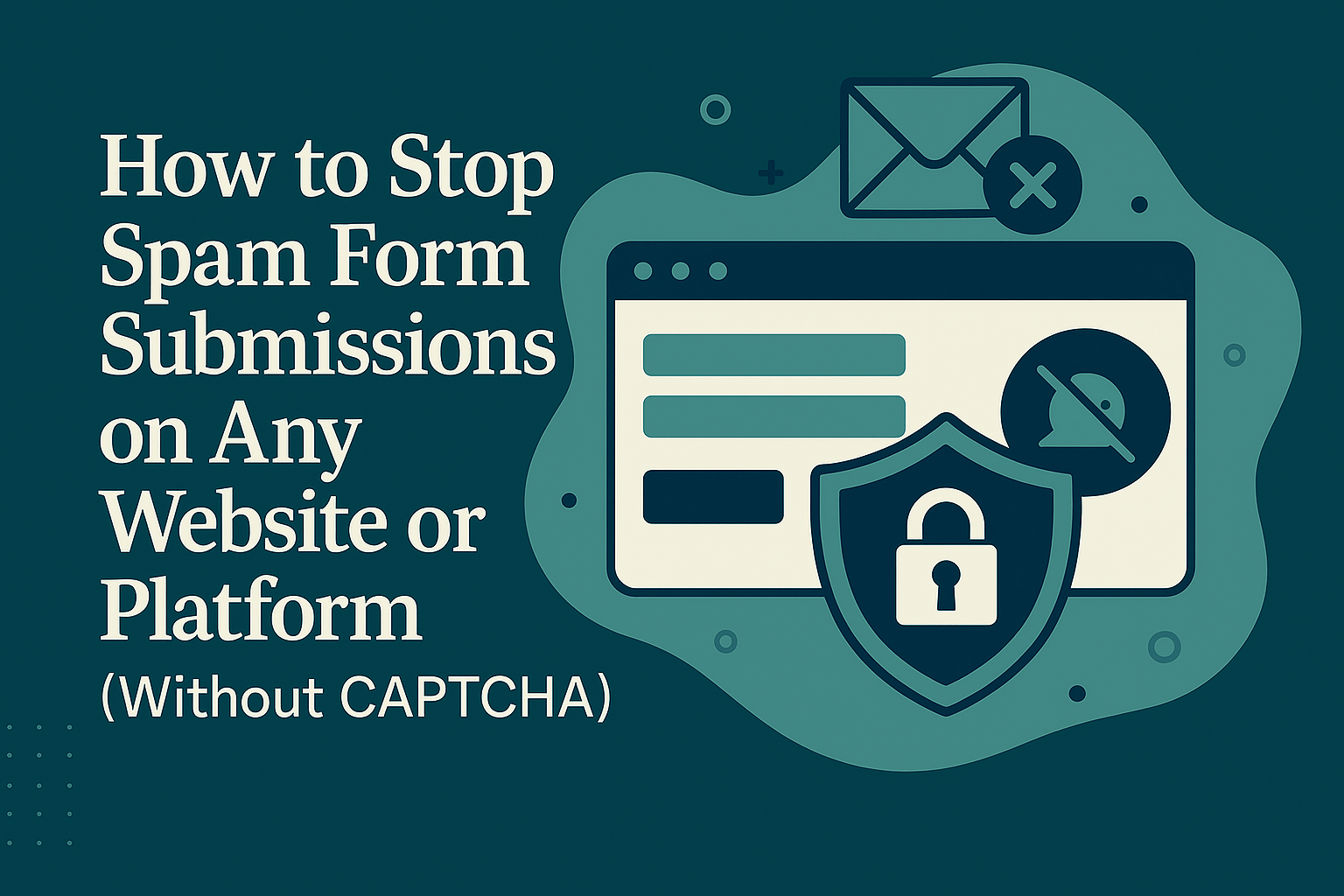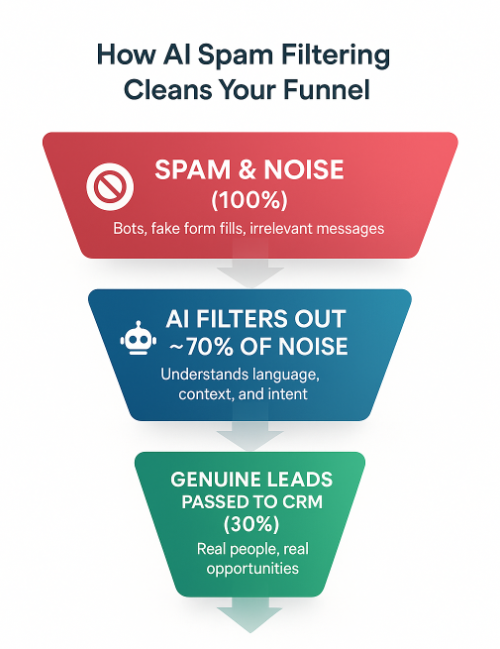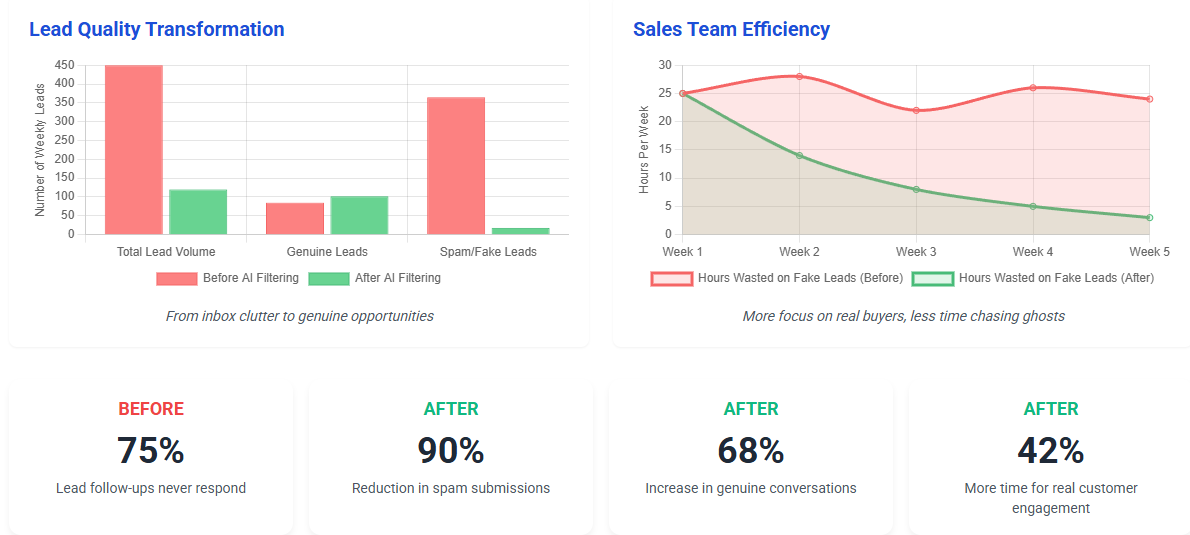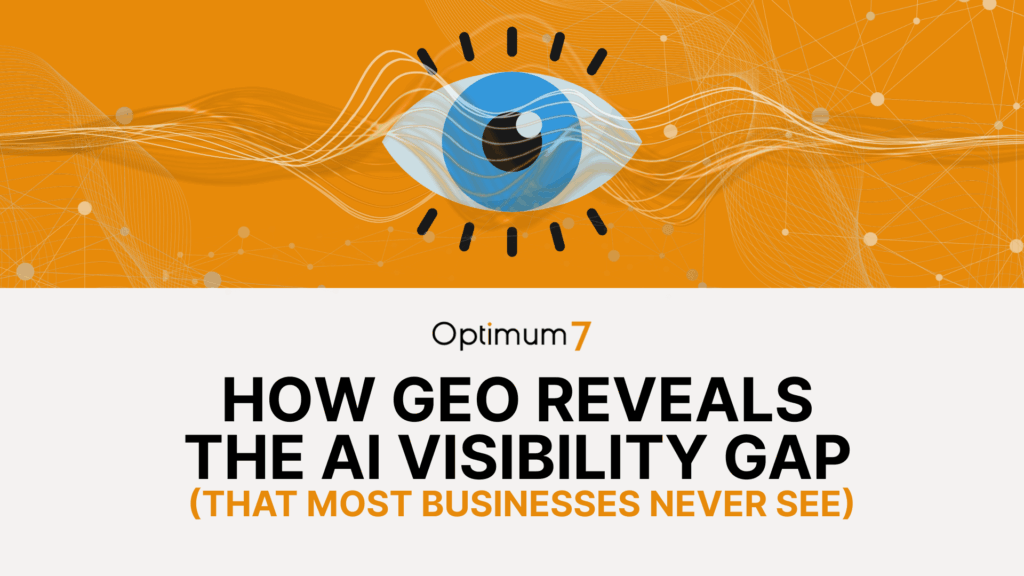The Universal Spam Problem
Every website owner knows the feeling: you open your inbox and see a flood of “new leads.”, half of them fake emails or spam mail from bots. It feels good until you start reading them. Half is nonsense. Some are bot-generated link-exchange pitches. Others are fake “quote requests” from nowhere. A few even look real at first glance, just long enough to waste a salesperson’s morning.
Spam form submissions are the quiet tax of doing business online. They creep in through Contact Us forms, quote requests, and demo sign-ups, polluting every part of your system. They waste sales time, inflate ad performance metrics, and corrupt the very data you rely on to make decisions. Your analytics tell you you’re converting, but your CRM says otherwise.
The problem isn’t just inconvenience; it’s distortion. When bots fill out your forms, they trigger thank-you pages that count as conversions in Google Ads or Meta. That means your campaigns look better than they are. You keep feeding budget into ad sets that don’t really work. Meanwhile, your sales team chases ghosts—fake emails, invalid phone numbers, and messages that lead nowhere.
Most businesses turn to CAPTCHA as a fix. It’s the old security blanket: a tiny checkbox or a blurry grid of traffic lights meant to separate humans from bots. But CAPTCHA was built for a simpler web. Bots have evolved, and real people have lost patience. Every extra click and every image test adds friction, and friction kills conversions. Especially on mobile.
There’s a better way, and it starts with AI. Intelligent filters that understand language, context, and intent can spot spam instantly and stop it at the gate. No puzzles, no hoops. Just clean, verified submissions that make sense.
That’s what this article is about: how AI-powered spam prevention can clean your pipeline, protect your sales team’s time, and finally make your analytics tell the truth again.
What Makes Spam Dangerous for Your Business
Spam doesn’t just clutter your inbox—it warps your business reality. On the surface, a few fake form fills might seem harmless, maybe even ignorable. But inside your systems, every false lead ripples through your marketing, sales, and reporting pipelines like a hidden toxin.
Start with advertising. Every time a bot fills out a form, it triggers your thank-you page—and that event fires back to Google Ads, Meta, or LinkedIn as a conversion. To your ad platform, that looks like success. Your dashboard says your campaign is performing beautifully. But the truth? Those “leads” don’t exist. They’re phantom conversions that inflate your metrics and mislead your budget. And now you end up spending more to get more of the same: fake leads built on false signals.
Then comes the human cost. Your sales team already starts chasing ghosts. They call disconnected numbers, send follow-up emails to addresses that bounce, and waste hours qualifying inquiries that were never real. Every minute they spend doing that is a minute they’re not talking to real prospects. Multiply that across a week, a month, a quarter—and suddenly you’re paying salaries to fight noise.
It doesn’t stop there. Spam pollutes your CRM. Over time, your database fills with junk records that throw off segmentation, automation, and reporting. You can’t trust your open rates, your MQL ratios, or your pipeline velocity—because half the numbers are based on trash.
And worst of all, spam distorts the truth. It makes you believe your marketing is working when it isn’t. It hides real problems under fake success.
That’s what makes spam so dangerous: not that it’s annoying, but that it’s deceptive. It tells you a comforting lie in your dashboards while quietly draining your resources. And CAPTCHA won’t save you. You need a smarter filter—one that understands meaning, not just movement.
That’s where AI comes in. Instead of blocking people, it analyzes language, intent, and behavior to stop spam before it ever hits your inbox—and to do it invisibly, without breaking your customer’s flow.
Why CAPTCHA Fails
CAPTCHA was once a clever invention—a quick test to tell humans and bots apart. Type the distorted letters, click all the crosswalks, and check the box that says “I’m not a robot” and it worked… for a while. But the internet evolved faster than CAPTCHA did.
Modern bots can now solve CAPTCHA puzzles as easily as humans. Entire services exist where AI models or even low-cost labor farms solve these challenges in real time for pennies. Meanwhile, real users are the ones who get stuck.
It’s easy to underestimate how much friction CAPTCHA adds until you watch a potential customer drop off. Someone visits your site, fills out a form, and then hits a wall of tiny boxes and blurry images. On mobile, it’s even worse—zooming in, tapping on a traffic light that’s half-cropped, refreshing because it didn’t register. By the time they finally pass, half of them have already left.
That’s the hidden cost of CAPTCHA: it doesn’t just block bots. It blocks buyers.
And even when it “works,” it’s not foolproof. Bots adapt. They mimic browser behavior, bypass scripts, or even scrape and auto-submit data through backend APIs that CAPTCHA never sees. The more sophisticated the bot, the less your front-end defenses matter.
For ecommerce brands and B2B companies, this creates a paradox. You can’t afford spam—but you also can’t afford to frustrate real customers with barriers. Traditional anti-spam tools force you to choose between accuracy and experience. AI changes that equation.
Where CAPTCHA asks users to prove they’re human, AI learns to recognize what’s human—and what’s not. It doesn’t interrupt the user. It observes patterns, context, and language in real time. That’s the difference between a gatekeeper and a guardian: one stops everyone until proven innocent; the other quietly protects without breaking the flow.
The AI-Powered Alternative
Think about it this way. Most spam filters just block things blindly—they don’t really understand what’s coming in. An AI-powered spam detection system works differently. It reads the message, understands intent, and decides what to do next—instantly. No puzzles, no CAPTCHA, no “prove you’re not a robot.” Just… logic.
Let’s say you keep getting those “link exchange” messages—you know the type: guest post, collaboration opportunity, DA 90 backlinks. Over and over. AI spots those patterns almost immediately—separating spam from non-spam messages before they ever reach your inbox.
Or maybe you sell industrial tools online, and every now and then someone asks for “Nike shoes.” Not spam exactly, just irrelevant. The AI gets it. It quietly filters them out, labels them as “off-topic,” and moves on. You don’t waste time sorting through noise. That’s the real difference. AI doesn’t treat every form the same. It routes smartly. Real leads go to your CRM. Random questions get redirected. Spam dies quietly.
And the best part—you’re in control. The system runs on a simple knowledge base: what’s okay, what’s not. If you want to start letting partnership requests through again, flip the setting. Need tighter rules on a few pages? Tweak and save. That’s it.
It turns spam control from a daily annoyance into something calm and automatic. No CAPTCHA. No hoops to jump through. It is just a system that quietly does the work and lets your team focus on what actually matters.
Key Benefits of AI Spam Filtering
When you finally fix spam, it feels like unclogging a pipe you didn’t realize was choking your business. Everything starts moving again through leads, conversations, and confidence. The chaos quiets down. You stop second-guessing every form submission and start trusting your numbers.
Real Messages, Real People
With AI spam filtering, you don’t wake up to 200 fake inquiries that start with “Dear Sir/Madam.” You wake up to five messages that actually matter. That one change—going from noise to clarity—reshapes how your day begins. You don’t need to sort, delete, or doubt. You just read and respond.
Analytics You Can Finally Believe
Once spam is gone, your dashboards stop lying to you. The thank-you page no longer fires for junk. Your conversion data starts reflecting reality—who’s really coming from your ads and which campaigns are actually working. The fog lifts. For the first time in a while, you can look at Google Ads or Meta numbers and trust them.
Your Sales Team Gets Their Time Back
There’s something demoralizing about chasing fake leads. It drains momentum, especially when the “new inquiry” turns out to be a bot pitching crypto. Once AI starts filtering, your salespeople stop wasting hours cleaning junk from the CRM. They go back to what they’re good at—building relationships with real buyers.
The System Handles the Awkward Stuff Gracefully
You don’t have to be rude to job seekers or random link builders. The AI can recognize those submissions, send a polite, on-brand message, and point them to the right place. It keeps your tone professional while saving your team from playing email traffic cop.
It Learns, Quietly, and Keeps Getting Better
The longer it runs, the smarter it gets. It starts recognizing subtle patterns—phrasing, tone, certain types of requests—that even humans might miss. You don’t need to micromanage it. You just start noticing that the junk stops showing up.
And then something subtle happens. Your inbox feels calmer. Your sales reports look cleaner. Your team stops sighing when a new lead notification comes in. You remember what qualified leads used to feel like—and you realize how much noise you’ve been living with.
How It Works Technically
Here’s the thing about good automation—you shouldn’t feel it working. It’s like electricity: invisible, constant, quietly holding everything together. AI spam filtering works the same way. It doesn’t sit on top of your form like a guard dog. It sits behind it, thinking in real time, watching every submission with a kind of quiet intelligence.
When someone hits “Submit,” the message isn’t just dumped into your inbox. It’s first scanned—not for keywords or red flags, but for meaning. The AI looks at sentence structure, tone, and context and notices if the message reads like a real person with a goal or like a script firing off automated nonsense.
Every form submission is compared against a knowledge base—a simple set of rules you define. For example:
- “Link exchange” or “guest post” requests? Block.
- “Career” or “résumé”? Redirect to HR.
- “Quote” or “pricing”? Pass through as high priority.
That’s the beauty of it—it’s not one-size-fits-all. You tell the AI what you consider spam or irrelevant, and it adapts around that. Over time, it even learns from patterns—understanding not just what words people use, but how real humans ask for help, quotes, or support.
Once the AI reviews a submission, it makes one of three simple calls.
1- Allow it: It’s a real lead—the kind you actually want. It goes straight to your inbox or CRM, no delay.
2- Reroute it: It’s not spam, just in the wrong place. Maybe a job application sent through your contact form or a message meant for another department. The system forwards it where it belongs, automatically.
3- Block it: It’s junk. The AI filters it out before anyone has to read it or waste a second on it.
And you’re never left in the dark. Every action gets logged. You can review what’s been blocked, redirected, or approved whenever you want. Nothing vanishes without a trace—it just stops burying your real work.
The setup is simple, but the difference it makes is huge. No more CAPTCHA puzzles. No more hoops for people to jump through. The system thinks before it acts—for you and for them. What’s left are clean, genuine leads flowing through a form that finally feels effortless.
Use Cases Across Platforms
Once you get how AI spam filtering works, the next question’s pretty simple: where does it fit? The answer—anywhere someone can type a message. Contact forms. Quote requests. Demo signups. Even customer inquiry pages. Every one of those is a door. And right now, most of them are wide open.
Contact Forms
This is usually the worst offender. The front door of your business gets hammered daily by bots pretending to be people. You’ve seen it—fake names, copy-paste messages about “partnerships” or “guest posts.” The AI learns the difference fast. It knows what a real customer sounds like and what a bot script looks like. Real messages get through. The rest never make it past the threshold.
Quote Request Forms
This one hits sales teams hardest. A new quote request shows up—looks legit—until you notice the Gmail address, no phone number, and a fake company name. The AI detects that pattern instantly by checking for missing data, weird language, and mismatched intent. Bad leads get filtered out. What’s left are the ones worth your time.
Demo or Trial Signups
If you offer free trials, you already know the pain: sudden spikes of fake signups that never log in. They mess with your analytics and bury real prospects. With AI screening, those get caught before they ever hit your dashboard. Bots are stopped cold. Only genuine users—real emails, real intent—get through. Your numbers start meaning something again.
B2B Lead Forms
B2B spam can be sneaky. It reads like a serious inquiry until you realize it’s someone trying to sell you something. The AI picks up on that tone—the mismatched intent, the structure of the message—and quietly removes it. You keep the real leads, not the sales pitches pretending to be them.
E-commerce Inquiry Forms
Online stores deal with a special kind of noise—questions about products you don’t even sell. “Do you have Nike shoes?” “Can I buy this luxury handbag?” None of it belongs in your inbox. The AI catches irrelevant product mentions and filters them out before your support team ever sees them.
Across all of these, the goal isn’t just blocking spam. It’s protecting focus. Every message that makes it through is real, relevant, and worth your attention. And that’s when things start to shift—your website stops being noisy background clutter and starts working for you again.
Real Business Impact
When a business finally fixes its spam problem, the change isn’t subtle. The first sign is quiet—a strange, satisfying silence in the inbox. No more middle-of-the-night “new lead” alerts that turn out to be gibberish. No more salespeople groaning when they open a form submission and see yet another fake name or half-written pitch. And as the noise fades, something else happens: your numbers start to make sense again.
Once spam disappears, your analytics shift from illusion to reality. Campaigns that used to look brilliant suddenly fall flat because they were never real to begin with—bots were triggering those thank-you pages, not customers. At first, that honesty stings. It’s hard to see inflated metrics fall. But it’s also liberating. You can finally trust what your reports are telling you. You can stop wasting ad dollars on fake clicks and start putting money into campaigns that actually move people.
The next thing you notice is flow. Without CAPTCHA standing in the way, more visitors complete your forms. There’s no friction—no boxes to tick, no tiny street signs to identify, no mobile frustration that makes people give up halfway through. Everything feels seamless again. Someone fills out a form, hits submit, and that’s it. On the backend, the AI is quietly scanning, filtering, and deciding what’s real. But the user never sees that part—they just experience a form that works.
Then comes the payoff. Sales teams stop losing hours sifting through junk. They spend their energy on genuine conversations with people who actually want to buy something. Marketing stops arguing with data. Support teams stop chasing empty tickets. The whole operation starts to breathe again. You can feel it in the pace of meetings, the tone of emails, and the focus that comes from knowing you’re no longer fighting ghosts.
And underneath all of that is trust—trust in your tools, in your numbers, and in the idea that when your business says “we got a lead,” it actually means something. Spam filtering isn’t glamorous. It’s not something you show off in a presentation. But once it’s fixed, everything downstream gets sharper. Your reports are cleaner, your people calmer, and your decisions grounded in truth instead of noise. It’s like tuning a radio station that’s been fuzzy for years—the moment you hear the signal clearly, you wonder how you ever tolerated the static.
What Could Happen When You Eliminate Spam
Imagine an industrial e-commerce company struggling with a familiar issue: hundreds of new “leads” flooding in every week, but very few turning into real conversations. The sales dashboard looks promising, yet the team can feel something’s off. They’re busier than ever, chasing inquiries that never reply, while campaign costs keep climbing.
If that company were to implement an AI-powered spam filtering system, there’s a strong possibility the entire picture could change. By adding a smart layer behind their forms—one that understands language, context, and intent—the AI could begin separating real leads from fake submissions automatically. Within days, the noise might start to disappear. Instead of dozens of useless “link exchange” or “guest post” requests, the inbox could hold only a handful of messages that actually matter.
In many cases like this, spam volume may drop drastically—sometimes even by more than 90%. The result isn’t just fewer emails; it’s clarity. Ad platforms would stop counting fake conversions. Data accuracy could return. Sales teams might regain time and focus, working with real buyers rather than chasing ghosts.
The impact of this shift isn’t purely technical—it’s cultural. Once teams start trusting their leads again, their energy changes. Conversations feel real. Pipelines look clean. And suddenly, the CRM becomes what it was meant to be: a system filled with genuine opportunities, not digital noise.
That’s the possibility with AI spam filtering: less clutter, more clarity, and a business finally seeing itself truthfully again.
Smart Spam Defense Guide
Spam shouldn’t be something you “live with.” It’s not the cost of doing business online — it’s a leak.
And leaks can be fixed. This toolkit lays out how to stop fake form submissions quietly, cleanly, and without forcing real people to jump through traffic-light puzzles.
The Problem Map: What You’re Really Fighting
| Type of Spam | What It Looks Like | Why It Slips Through | What Gives It Away | Best Fix |
| Bot Blasts | Dozens of identical messages in seconds | Bypass front-end forms | Repeated IPs, identical phrases | Block them automatically |
| “Outreach” Pitches | Guest posts, DA 90 links, crypto promos | Too random for keyword filters | Patterns in tone and link density | Block |
| Job Applicants | Real people, wrong door | Use your contact form instead of Careers | Résumé terms, LinkedIn URLs | Reroute to HR |
| Off-Topic Inquiries | Asking for products you don’t sell | Honest mistake, not spam | Product mismatch, brand confusion | Auto-reply with right info |
| Scripted API Attacks | Direct backend hits | CAPTCHA can’t even see them | Empty headers, suspicious user agents | Block + rate limit |
The goal isn’t just “less spam.” It’s clean data, real leads, and a smoother experience for people who actually want to talk to you.
Your Personal Rulebook
| Rule | What to Look For | Certainty | What Happens |
| SEO / Link Requests | “guest post,” “link exchange,” “sponsored post” | High | Blocked on arrival |
| Crypto / Scam Content | “USDT,” “binary options,” “airdrop” | High | Blocked silently |
| Job Applications | Mentions of “résumé,” “portfolio,” LinkedIn/GitHub links | High | Redirected to HR with polite message |
| Product Confusion | Mentions of unrelated brands | Medium | Auto-reply with correct link |
| Missing Details | No company, fake phone, generic Gmail | Medium | Marked for review |
| Repeat Messages | Same body from multiple emails | High | Blocked and throttled |
The magic isn’t in catching everything. It’s in learning fast. Every pattern you add becomes permanent protection.
How the System Actually Works (Without Slowing Anyone Down)
| Layer | What It Does | Why It Matters |
| Input Gateway | Collects every submission from every form — safely, server-side. | Stops bots that sneak around front-end scripts. |
| AI Classifier | Reads the message for meaning, tone, and intent — not just keywords. | Filters like a human would, but instantly. |
| Reputation Check | Scans IPs, domains, and device history. | Flags repeat offenders before they hit your inbox. |
| Rules Engine | Applies your custom rules and confidence scores. | Keeps full control in your hands — no black box. |
| Smart Router | Sends real leads to CRM, job applications to HR, support issues to Helpdesk. | Messages land exactly where they belong. |
| Communication Layer | Sends friendly auto-replies to rerouted messages. | Keeps your tone human while saving your team’s time. |
| Audit Trail | Logs every decision — what passed, what didn’t, and why. | Gives you transparency if something slips through. |
Think of it like a silent assistant — polite to your customers, ruthless to the bots.
Launch Checklist
Here’s what to double-check before you go live:
Setup
☐ All your forms send data through one secure backend endpoint (no client-side loopholes).
☐ CRM, HR, and Support inboxes are mapped to the correct routes.
☐ Webhooks or middleware are tested and working.
AI Logic
☐ The classifier recognizes intent types (lead, spam, misrouted).
☐ Your Rule Library reflects your real spam patterns.
☐ Confidence levels are tuned — low = block, middle = review, high = allow.
User Experience
☐ No CAPTCHA or “prove you’re human” steps.
☐ Auto-replies are kind, clear, and on-brand.
☐ Submissions feel instant, not filtered.
Maintenance
☐ Audit log is live and visible to your team.
☐ Weekly: review false positives and new spam types.
☐ Monthly: update rules, retrain AI, archive logs.
☐ Alert triggers for sudden spikes in submission volume.
When this list is fully checked, you’ll know you’ve hit the sweet spot — no friction for customers, no fake leads for sales, and no time wasted cleaning inboxes.
-Spam filtering isn’t about blocking people—it’s about protecting focus. Once the noise is gone, your analytics get honest, your sales team gets lighter, and your mornings start without that sinking feeling that the “new leads” aren’t real.
Reclaim Your Data, Your Time, and Your Focus
For years, businesses have accepted spam as part of life online—just another mess to clean up every morning. We got used to the noise, the fake inquiries, and the wasted hours chasing names that lead nowhere. We built entire workflows around filtering what should never have existed in the first place. Somewhere along the way, we started calling that normal.
But it isn’t normal. It’s expensive, distracting, and quietly corrosive. Every spam form that slips through your site wastes someone’s time, corrupts your data, and feeds your analytics a lie. The more it happens, the harder it becomes to see what’s real, and when you can’t trust your own numbers, you can’t make confident decisions.
That’s why this shift matters. AI spam filtering doesn’t just block junk; it restores clarity. It gives you an inbox that feels honest again—a CRM full of names that belong to real people, not empty lines of text. It untangles your marketing data so you can finally see which campaigns work and which ones never did. It gives your sales team their rhythm back. It gives your business the peace that comes with knowing everything flowing through your site is authentic.
If you’ve felt that frustration—the sense that your reports look too good to be true, that your “leads” feel empty, that your team is working harder for less — then this is your signal. You don’t have to live with the noise anymore.
Contact us at Optimum7, and let’s clean it up — together. We’ll show you exactly how to stop spam across every form, every platform, without slowing down a single real customer. We’ll help you rebuild the simple, powerful truth that used to drive your business: when someone fills out a form, it means something.
Because the goal isn’t just fewer spam submissions. The goal is getting your time, your focus, and your confidence back.













